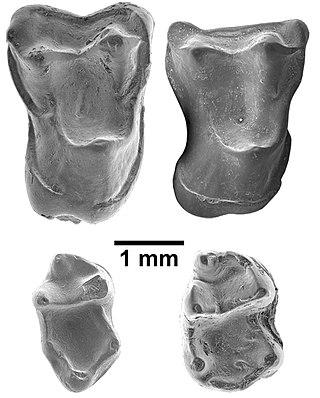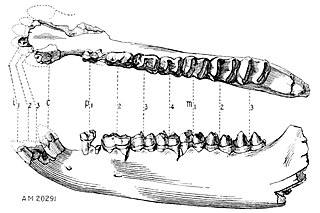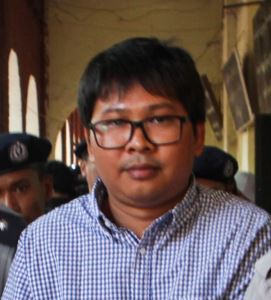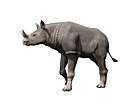Related Research Articles

Andrewsarchus, meaning "Andrews' ruler", is an extinct genus of artiodactyl that lived during the Middle Eocene in what is now China. The genus was first described by Henry Fairfield Osborn in 1924 with the type species A. mongoliensis based on a largely complete cranium. A second species, A. crassum, was described in 1977 based on teeth. A mandible, formerly described as Paratriisodon, does probably belong to Andrewsarchus as well. The genus has been historically placed in the families Mesonychidae or Arctocyonidae, or was considered to be a close relative of whales. It is now regarded as the sole member of its own family, Andrewsarchidae, and may have been related to entelodonts. Fossils of Andrewsarchus have been recovered from the Middle Eocene Irdin Manha, Lushi, and Dongjun Formations of Inner Mongolia, each dated to the Irdinmanhan Asian land mammal age.

The Anti-Fascist People's Freedom League (AFPFL) was the dominant political alliance in Burma from 1945 to 1958. It consisted of political parties and mass and class organizations.

The Supreme Court of Myanmar is the highest judicial forum and final court of appeal under the Constitution of Myanmar, existing as an independent judicial entity, alongside the legislative and executive branches. The Court is legally mandated to have 7 to 11 judges, including a Chief Justice.
Hsanotherium is an extinct genus of early ungulate from the middle Eocene, described in 2000 in the Pondaung Formation, Myanmar.

The Japanese occupation of Burma was the period between 1942 and 1945 during World War II, when Burma was occupied by the Empire of Japan. The Japanese had assisted formation of the Burma Independence Army, and trained the Thirty Comrades, who were the founders of the modern Armed Forces (Tatmadaw). The Burmese hoped to gain support of the Japanese in expelling the British, so that Burma could become independent.

Insein Prison is located in Yangon Division, near Yangon (Rangoon), the old capital of Myanmar. From 1988 to 2011 it was run by the military junta of Myanmar, named the State Law and Order Restoration Council from 1988 to 2003 and the State Peace and Development Council (SPDC) from 2003 to 2011, and was used largely to repress political dissidents.
Anthracothema was a genus of extinct artiodactyl ungulate mammals that lived in Myanmar during the late Eocene.

Anthracokeryx is a genus of extinct artiodactyl ungulate mammal belonging to Anthracotheriidae that lived in Asia during the middle to late Eocene.
Anthracohyus was a genus of extinct artiodactyl ungulate mammal belonging to Anthracotheriidae that lived in Asia during the middle to late Eocene.
Ganlea is a fossil primate from central Myanmar, formerly known as Burma. Its age is about 38 million years, living during the late Eocene epoch. Ganlea belongs to the group of anthropoids, and is in the family Amphipithecidae. It is older than any other known anthropoid from Africa, and is the second oldest known from Asia. Its remains consist of teeth and jawbones belonging to 10 to 15 individuals found near the city of Bagan in the central part of the country.
Khin Maung (Bank) (ခင်မောင် ; 1910 – 20 December 1983) was a Burmese painter and sponsor of the arts who was influential in the art world of Mandalay, Myanmar. More importantly, however, he was the major force for the development of a modernistic movement in painting in Burma, which began in the early 1960s.

Bagyi Aung Soe was a Burmese painter renowned for his modernistic, semi-abstract art, which caused such a shock in Burma when it appeared that many called it "psychopathic art". The name "Bagyi" is his phonetic spelling of the word "pangyi", meaning "painting", which he first added to his name in 1955.

Gandheralophus is an extinct genus of isectolophid perissodactyl mammal known from the Eocene of Pakistan, with two known species: G. minor and G. robustus, both described in 2012.

Afrasia djijidae is a fossil primate that lived in Myanmar approximately 37 million years ago, during the late middle Eocene. The only species in the genus Afrasia, it was a small primate, estimated to weigh around 100 grams (3.5 oz). Despite the significant geographic distance between them, Afrasia is thought to be closely related to Afrotarsius, an enigmatic fossil found in Libya and Egypt that dates to 38–39 million years ago. If this relationship is correct, it suggests that early simians dispersed from Asia to Africa during the middle Eocene and would add further support to the hypothesis that the first simians evolved in Asia, not Africa. Neither Afrasia nor Afrotarsius, which together form the family Afrotarsiidae, is considered ancestral to living simians, but they are part of a side branch or stem group known as eosimiiforms. Because they did not give rise to the stem simians that are known from the same deposits in Africa, early Asian simians are thought to have dispersed from Asia to Africa more than once prior to the late middle Eocene. Such dispersals from Asia to Africa also were seen around the same time in other mammalian groups, including hystricognathous rodents and anthracotheres.

Afrotarsius is a primate found in the Paleogene of Africa.

Deperetellidae is an extinct family of herbivorous odd-toed ungulates containing the genera Bahinolophus, Deperetella, Irenolophus, and Teleolophus. Their closest living relatives are tapirs. Deperetellids are known from the Middle Eocene deposits of China, Mongolia, Kyrgyzstan and Myanmar.

Deperetella is an extinct genus of deperetellid perissodactyls from Middle to Late Eocene of Asia. The genus was defined in 1925 by W. D. Matthew and Walter W. Granger, who named it after French paleontologist Charles Depéret. The type species is Deperetella cristata.
The Amphipithecidae were simian primates that lived in Late Eocene and Early Oligocene. Fossils have been found in Myanmar, Thailand, and Pakistan. The limited fossil evidence is consistent with, but not exclusive to, arboreal quadrupedalism. In other words, the species may have moved about in trees on four legs, but not with regular leaping as seen in later simians.
Orienspterodon is an extinct genus of hyainailourid hyaenodonts from paraphyletic subfamily Hyainailourinae that lived in China and Myanmar during the middle to late Eocene. Orienspterodon dahkoensis was originally assigned to genus Pterodon in 1975, but was eventually assigned to its own genus in 2007.

Wa Lone is a Reuters journalist and children's author who, with fellow reporter Kyaw Soe Oo, was arrested on 12 December 2017 in Myanmar because of their investigation into the Inn Din massacre. A police witness testified that their arrest was a case of entrapment. It is believed to have been intended to intimidate journalists.
References
- ↑ G. E. Pilgrim. 1925. The Perissodactyla of the Eocene of Burma. Memoirs of the Geological Survey of India 8(3):1-28.
- ↑ Tsubamoto, T., Soe Thura Tun, Egi, N., Takai, M., Shigehara, N., Aung Naing Soe, Aye Ko Aung, and Tin Thein. 2003. Reevaluation of some ungulate mammals from the Eocene Pondaung Formation, Myanmar. Paleontological Research, 7:219-243.









